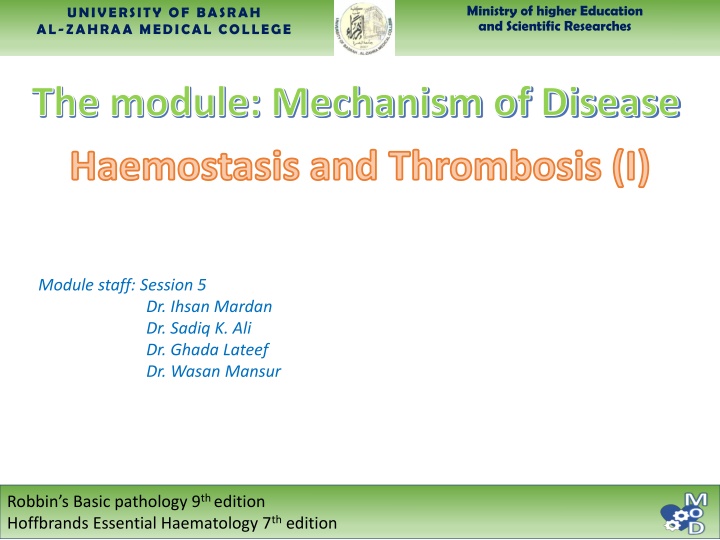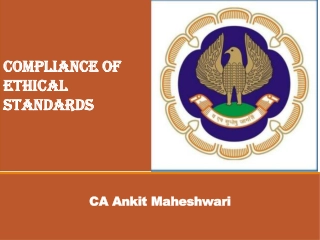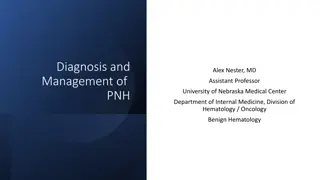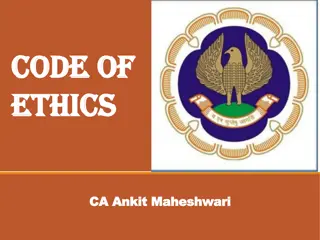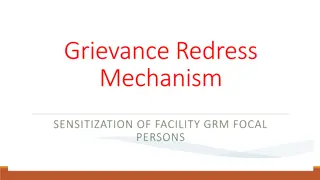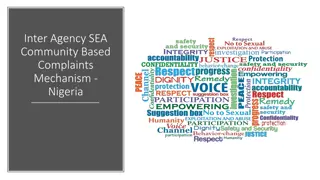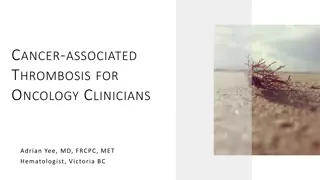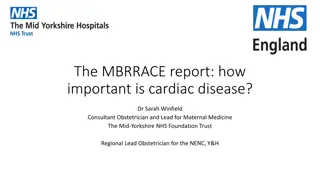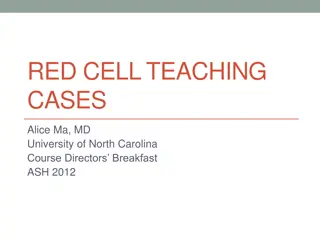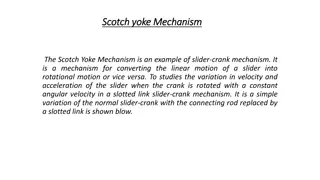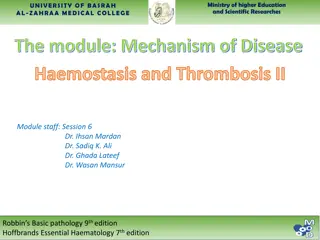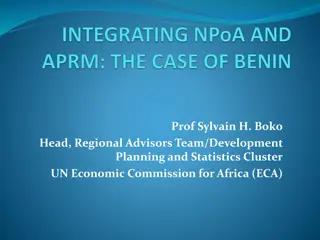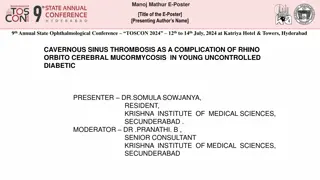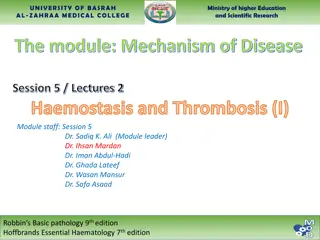The module: Mechanism of Disease Haemostasis and Thrombosis (I)
The module at the UNIVERSITY OF BASRAH AL-ZAHRAA MEDICAL COLLEGE delves into the intricate processes of haemostasis and thrombosis, emphasizing the balance between coagulant and anticoagulant factors, the role of platelets, and the effects of thrombosis on vascular integrity. Explore how haemostasis maintains blood in a fluid state while forming localized plugs to arrest bleeding at injury sites, ensuring vascular health.
Download Presentation

Please find below an Image/Link to download the presentation.
The content on the website is provided AS IS for your information and personal use only. It may not be sold, licensed, or shared on other websites without obtaining consent from the author.If you encounter any issues during the download, it is possible that the publisher has removed the file from their server.
You are allowed to download the files provided on this website for personal or commercial use, subject to the condition that they are used lawfully. All files are the property of their respective owners.
The content on the website is provided AS IS for your information and personal use only. It may not be sold, licensed, or shared on other websites without obtaining consent from the author.
E N D
Presentation Transcript
Ministry of higher Education and Scientific Researches UNIVERSITY OF BASRAH AL-ZAHRAA MEDICAL COLLEGE The module: Mechanism of Disease Haemostasis and Thrombosis (I) Module staff: Session 5 Dr. Ihsan Mardan Dr. Sadiq K. Ali Dr. Ghada Lateef Dr. Wasan Mansur Robbin s Basic pathology 9th edition Hoffbrands Essential Haematology 7thedition
Ministry of higher Education and Scientific Researches UNIVERSITY OF BASRAH AL-ZAHRAA MEDICAL COLLEGE Learning objectives: 1. Haemostasis; Definition Balance of coagulant and anticoagulant factors Intrinsic and extrinsic pathways Role of platelets Fibrinolytic system 2. Thrombosis; Definition Predisposing factors Effects of thrombosis Outcomes
The health of cells and tissues depends on an intact circulation to deliver oxygen and remove wastes and on normal fluid homeostasis. normal fluid homeostasismeans maintaining blood as a liquid until clot formation is mandatory.
1- HAEMOSTASIS Why don t you bleed to death from a minor injury?
1- HAEMOSTASIS Haemostasis refers more widely to the process whereby blood coagulation is initiated and terminated in a tightly regulated fashion, together with the removal (or fibrinolysis) of the clot as part of vascular remodelling. Global process by which vascular integrity and patency are maintained over the whole organism, for its lifetime. Normal haemostasis comprises a series of regulated processes that maintain blood in a fluid, clot-free state in normal vessels while rapidly forming a localized haemostatic plug at the site of vascular injury.
HAEMOSTASIS The haemostatic mechanisms have several important functions: (1) to maintain blood in a fluid state while it remains circulating within the vascular system; (2) to arrest bleeding at the site of injury or blood loss by formation of a haemostatic plug; (3) to limit this process to the vicinity of the damage and (4) to ensure the eventual removal of the plug whilst healing is completed
HAEMOSTASIS There are at least five different components involved: 1. blood vessels, 2. platelets, 3. plasma coagulation factors and 4. their inhibitors and 5. the fibrinolytic system. Deficiency or exaggeration of any one may lead to either thrombosis or haemorrhage
ENDOTHELIUM Central regulators of haemostasis The balance between the antithrombotic and prothrombotic activities of endothelium determines whether thrombus formation, dissolution occurs. propagation, or At baseline, endothelial cells exhibit antithrombotic (antiplatelet, anticoagulant, and fibrinolytic properties), however, they are capable (after injury or activation) of exhibiting numerous procoagulant activities.
Antithrombotic Properties (Endothelium) Antiplatelet Effects An intact endothelium prevents platelets (and plasma coagulation factors) from interacting with the highly thrombogenic subendothelial extracellular matrix (ECM). Prostacyclin (PGI2) and nitric oxide (NO). Adenosine diphosphatase. Anticoagulant Effects Heparin-like molecules, thrombomodulin and tissue factor pathway inhibitor Fibrinolytic Effects Plasminogen activator (t-PA)
Prothrombotic Properties (Endothelium) Platelet effects: Endothelial injury brings platelets into contact with the subendothelial ECM, which includes among its constituents von Willebrand factor (vWF) Procoagulant effects. In response to cytokines (e.g., tumour necrosis factor [TNF] or interleukin-1 [IL-1]) or certain bacterial products endothelial cells produce tissue factor, the major in vivo activator of coagulation, and downregulate the expression of thrombomodulin. including endotoxin, Antifibrinolytic effects. Endothelial cells also secrete inhibitors of plasminogen activator (PAIs)
Endothelial Cells and Coagulation (summary) Intact, normal endothelial cells help to maintain blood flow by inhibiting the activation of platelets and coagulation factors. Endothelial cells stimulated by injury or inflammatory cytokines upregulate expression of procoagulant factors (e.g., tissue factor) that promote clotting, and downregulate expression of anticoagulant factors. Loss of endothelial integrity exposes subendothelial vWF and basement membrane collagen, stimulating platelet adhesion, platelet activation, and clot formation.
PLATELETS Platelets play a critical role in normal haemostasis by forming a haemostatic plug that seals vascular defects, and by providing a surface that recruits and concentrates activated coagulation factors. Normal platelet count is 150-400 x 109/L. After vascular injury, platelets encounter ECM constituents (collagen is most important) and adhesive glycoproteins such as vWF.
This sets in motion a series of events that lead to; (1) Platelet adhesion, (2) Platelet activation, and (3) Platelet aggregation. Platelet Adhesion Platelet adhesion initiates clot formation. Adhesion to ECM is mediated largely via interactions with vWF that acting as a bridge between platelet surface receptors (e.g., GpIb) and exposed collagen.
Platelet Activation Secretion of both granule types ( granules and granules) occurs soon after adhesion. The subtle membrane changes include an increase in the surface expression of negatively charged phospholipids, which provide binding sites for both calcium and coagulation factors, and a conformation change in platelet GpIIb/IIIa that permits it to bind fibrinogen.
Platelet Aggregation Aggregation follows platelet adhesion and granule release. In addition to ADP, platelet-synthesized thromboxane A2 which is an important stimulus for platelet aggregation. Aggregation is promoted by bridging interactions between fibrinogen and GpIIb/IIIa receptors on adjacent platelets. ADP and TXA2 promotes formation of an enlarging platelet aggregate, the primary haemostatic plug.
This primary aggregation is reversible. However, with activation of the coagulation cascade, the generation of thrombin results in two processes that make an irreversible haemostatic plug. Thrombin binds to a platelet surface receptor (protease- activated receptor, or PAR); in association with ADP and TXA2, this interaction aggregation. Platelet contraction follows, creating an irreversibly fused mass of platelets constituting the definitive secondary haemostatic plug. induces further platelet Concurrently, thrombin converts fibrinogen to fibrin within and about the platelet plug, contributing to the overall stability of the clot.
Platelet Adhesion, Activation, and Aggregation (summary) Endothelial injury exposes the underlying basement membrane ECM; platelets adhere to the ECM primarily through binding of platelet GpIb receptors to vWF. Adhesion leads to platelet activation, an event associated with secretion of platelet granule contents, including calcium and ADP, dramatic changes in shape and membrane composition; and activation of GpIIb/IIIa receptors. The GpIIb/IIIa receptors on activated platelets form bridging crosslinks with fibrinogen, leading to platelet aggregation. Concomitant activation of thrombin promotes fibrin deposition, cementing the platelet plug in place.
COAGULATION CACGADE The coagulation cascade is a successive series of amplifying enzymatic reactions. At each step in the process, a proenzyme is proteolyzed to become an active enzyme, which in turn proteolyzes the next proenzyme in the series, eventually leading to the activation of thrombin and the formation of fibrin. These components typically are assembled on a phospholipid surface and are held together by interactions that depend on calcium ions.
Once activated, the coagulation cascade must be tightly restricted to the site of injury to prevent inappropriate and potentially dangerous clotting elsewhere in the vascular tree. In addition to the restriction of factor activation to sites of exposed phospholipids, three categories of natural anticoagulants function to control clotting: 1. antithrombins, 2. proteins C and S, and 3. tissue factor pathway inhibitor (TFPI).
Antithrombins (e.g., antithrombin III) inhibit the activity of thrombin and other serine proteases, factors IXa, Xa, XIa, and XIIa. Proteins C and S are two vitamin K-dependent proteins that inactivate the cofactors Va and VIIIa. Tissue factor pathway inhibitor (TFPI) is a protein secreted by endothelium (and other cell types) that inactivates factor Xa and tissue factor factor VIIa complexes
The coagulation cascade. The traditional concept of blood coagulation with separate intrinsic (red) and extrinsic (blue) pathways converging on the common pathway (green) with the generation of FXa.
FIBRINOLYTIC SYSTEM Fibrinolysis is largely carried out by plasmin, which breaks down fibrin and interferes with its polymerization The resulting fibrin split products (FSPs or fibrin degradation products). Elevated levels of FSPs (most notably fibrin-derived D-dimers) can be used for diagnosing abnormal thrombotic states including disseminated intravascular coagulation (DIC), deep venous thrombosis, or pulmonary thromboembolism.
Plasmin is generated by proteolysis of plasminogen, an inactive plasma precursor, either by factor XII or by plasminogen activators: Tissue-type plasminogen activator (t-PA) is the most important of the plasminogen activators. Urokinase-like plasminogen activator (u-PA) is another plasminogen activator present in plasma and in various tissues; it can activate plasmin in the fluid phase. Streptokinase, is bacterial product which is used clinically to lyse clots in some forms of thrombotic disease.
To prevent excess plasmin from lysing thrombi indiscriminately throughout the body, free plasmin rapidly complexes with circulating 2-antiplasmin and is inactivated. Endothelial cells further modulate the coagulation anticoagulation balance by releasing plasminogen activator inhibitors (PAIs) {PAIs increased by inflammatory cytokines that s why thrombosis occurs in severe inflammation}.
Coagulation Factors (summary) Coagulation occurs via the sequential enzymatic conversion of a cascade of circulating and locally synthesized proteins. Tissue factor elaborated at sites of injury is the most important initiator of the coagulation cascade in vivo. At the final stage of coagulation, thrombin converts fibrinogen into insoluble fibrin that contributes to formation of the definitive haemostatic plug.
Coagulation Factors (summary) Coagulation normally is restricted to sites of vascular injury by: limiting enzymatic activation to phospholipid surfaces provided by activated platelets or endothelium. natural anticoagulants elaborated at sites of endothelial injury or during activation of the coagulation cascade. expression of thrombomodulin on normal endothelial cells, which binds thrombin and converts it into an anticoagulant. activation of fibrinolytic pathways (e.g., by association of tissue plasminogen activator with fibrin) The coagulation assay can be assessed by PT, APTT and INR.
2- THROMBOSIS The pathologic counterpart of haemostasis is thrombosis, the formation of blood clot (thrombus) within intact vessels. The three primary abnormalities that lead to thrombus formation (Virchow s triad): (1) endothelial injury, (2) stasis or turbulence of blood flow, and (3) blood hypercoagulability
Endothelial Injury Endothelial injury is an important cause of thrombosis, particularly in the heart and the arteries (e.g., thrombi in the cardiac chambers after myocardial infarction) Dysfunctional endothelium (hypertension) elaborates greater amounts of procoagulant factors (e.g., platelet adhesion molecules, tissue factor, PAI) and synthesizes lesser amounts of anticoagulant molecules (e.g., thrombomodulin, PGI2, t-PA).
Alterations in Normal Blood Flow Turbulence thrombosis by causing endothelial injury or dysfunction, as well as by forming countercurrents and local pockets of stasis; stasis is a major contributor to the development of venous thrombi. contributes to arterial and cardiac Hyperviscosity syndromes (such as polycythemia) increase resistance to flow and cause small vessel stasis; the deformed red cells in sickle cell anemia cause vascular occlusions, and the resultant stasis also predisposes to thrombosis.
Hypercoagulability Hypercoagulability contributes infrequently to arterial or intracardiac thrombosis but is an important underlying risk factor for venous thrombosis. It is loosely defined as any alteration of the coagulation pathways that predisposes to thrombosis, and it can be divided into primary (genetic) and secondary (acquired) disorders:
Morphology Thrombi can develop anywhere in the cardiovascular system (e.g., in cardiac chambers, on valves, or in arteries, veins, or capillaries). The size and shape of a thrombus depend on the site of origin and the cause Arterial or cardiac thrombi typically arise at sites of endothelial injury or turbulence; venous thrombi characteristically occur at sites of stasis. Thrombi are focally attached to the underlying vascular surface and tend to propagate toward the heart; thus, arterial thrombi grow in a retrograde direction , while venous thrombi extend in the direction of blood flow.
The propagating portion of a thrombus tends to be poorly attached and therefore prone to fragmentation and migration through the blood as an embolus. Thrombi can have grossly (and microscopically) apparent laminations called lines of Zahn; these represent pale platelet and fibrin layers alternating with darker red cell rich layers. Such lines are significant in that they are only found in thrombi that form in flowing blood. Their presence can therefore antemortem thrombosis from the nonlaminated clots that form in the postmortem state. usually distinguish
Arterial thrombi are typically relatively rich in platelets, as the processes underlying endothelial injury) lead to platelet activation. their development (e.g., Venous thrombi (phlebothrombosis) frequently propagate some distance toward the heart that is prone to give rise to emboli. Venous thrombosis is largely the result of activation of the coagulation cascade, and platelets play a secondary role. Because these thrombi form in the sluggish venous circulation, they tend to contain more enmeshed red cells, leading to the red, or stasis, thrombi. The veins of the lower extremities are most commonly affected (90% of venous thromboses). Thrombi on heart valves are called vegetations.
Fate of the Thrombus Propagation. Embolization.. Dissolution. Organization and recanalization.
Fate of the Thrombus Propagation: The thrombus enlarges through the accretion of additional platelets and fibrin. Embolization: Part or all of the thrombus is dislodged and transported elsewhere in the vasculature. Dissolution: If a thrombus is newly formed, activation of fibrinolytic factors may lead to its rapid shrinkage and complete dissolution.
Fate of the Thrombus With older thrombi, extensive fibrin polymerization renders the thrombus substantially more resistant to plasmin-induced proteolysis, and lysis is ineffectual. Therapeutic administration of fibrinolytic agents is not effective unless given within a few hours of thrombus formation. Organization and recanalization: Older thrombi become organized by the ingrowth of endothelial cells, smooth muscle cells, and fibroblasts into the fibrin-rich thrombus.
